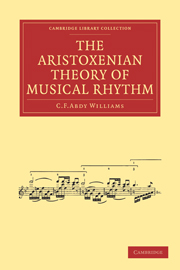Book contents
- Frontmatter
- PREFACE
- Contents
- MUSICAL ILLUSTRATIONS
- INTRODUCTION
- CHAPTER I
- CHAPTER II
- CHAPTER III
- CHAPTER IV
- CHAPTER V
- CHAPTER VI
- CHAPTER VII
- CHAPTER VIII
- CHAPTER IX
- CHAPTER X
- APPENDIX A Quotations, from original sources, of passages referred to in the text
- APPENDIX B Glossary of Technical Terms
- APPENDIX C Dactylo-epitritic, Logaœdic, and Dochmiac rhythms, and rhythmical modulation. M. Laloy's views
- INDEX
- Frontmatter
- PREFACE
- Contents
- MUSICAL ILLUSTRATIONS
- INTRODUCTION
- CHAPTER I
- CHAPTER II
- CHAPTER III
- CHAPTER IV
- CHAPTER V
- CHAPTER VI
- CHAPTER VII
- CHAPTER VIII
- CHAPTER IX
- CHAPTER X
- APPENDIX A Quotations, from original sources, of passages referred to in the text
- APPENDIX B Glossary of Technical Terms
- APPENDIX C Dactylo-epitritic, Logaœdic, and Dochmiac rhythms, and rhythmical modulation. M. Laloy's views
- INDEX
Summary
To the Greek musician the laws of rhythm were as important as those of harmony and counterpoint are to the modern student. Indeed the Greeks went further than we do, for they considered that the various forms of rhythm had certain definite emotional effects on the mind, and rules were formulated as to what particular kind of rhythm was suitable to express this or that emotion. An appeal was always to be made to the “Aisthēsis,” that part of our nature which we vaguely refer to as the “feeling,” in German “das Gefühl,” the faculty of mental perception, as opposed to bodily sensation.
Modern musicians sometimes attribute a certain tinge of melancholy to the minor mode, but further than this they do not go: no one has yet laid down rules that any particular form of harmony or species of counterpoint is suitable to this or that emotion. It is inconceivable that a modern composer should submit to rules in the matter of expression. Yet the Greek composers of the classical period not only used certain “modes,” but moulded their great works according to rule in definite rhythmical forms, that seem to have been understood at the time as expressing the particular appeal to the “Aisthēsis” that was required. These forms can be appreciated by us as rhythmical structures, but apart from the words they do not necessarily connect themselves in our mind with definite emotional effects.
- Type
- Chapter
- Information
- The Aristoxenian Theory of Musical Rhythm , pp. 1 - 8Publisher: Cambridge University PressPrint publication year: 2009First published in: 1911



